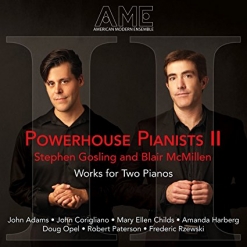
Powerhouse Pianists II
Stephen Gosling and Blair McMillen
2015 / American Modern Recordings
70 minutes
Review by Kathy Parsons
Powerhouse Pianists II is the very aptly-titled compilation of four hand/two piano works composed by artists from the American Modern Ensemble and performed by Stephen Gosling (a founding member of AME) and Blair McMillen. The seven composers present a total of eleven tracks since the pieces by Robert Paterson and John Corigliano are both three-movement works. The variety in the music is staggering, as is the virtuosity of the two pianists. I have played the piano for most of my life and have taught piano for the past thirty-six years, and I can’t even imagine trying to read some of this music let alone play it! I have a deep and sincere appreciation for the artistry that went into this album, but have to admit that I find some of it very challenging to listen to. Beauty is in the ear as well as the eye of the beholder, but if you are looking for a soothing piano album or music for meditation, you should probably move on.
Powerhouse Pianists II begins with “Deep Blue Ocean,” a three-movement piece by Robert Paterson. To my ears, this is the most accessible work on the album. Paterson has a way of creating colorful visual images through sound that allows the listener to share the experience that inspired the music. In this case, the inspiration came from a scuba-diving trip to the Gulf of Mexico and the visual wonders that were encountered while exploring the ocean’s depths. When Paterson was composing the music, the worst oil spill in US history occurred just north of where he had gone diving, and the darker passages in the music represent that tragedy. I highly recommend this portion of the album!
“Dilukkenion” by Doug Opel was originally composed for orchestra. The two-piano version is a competition of sorts between the two pianists, each trying to out-do the other while racing to “find” the fragments of an original canzona and a Bach Chorale. I would love to see this piece performed in a live setting and to be able to see who is playing what.
“Subway” is the first of a three-movement work called “Tenement Rhapsody” by Amanda Harberg. Each movement depicts a part of New York City that was central to her experience while living there. This one was inspired by the dynamic sights and loud, bustling sounds of Union Square Station during an evening rush hour.
Mary Ellen Childs’ “Kilter” is fascinating. It begins with the piano strings being plucked (or muted) in a steady rhythm. Gradually the keys (or the other piano) start(s) to be used. After about a minute, the music begins to intensify and darken. Childs has a strong background in dance, so it comes as no surprise that her music is rhythmic and in constant motion. This piece addresses the concept of being both in and out of balance, so some passages are very calm and peaceful and others are bold and turbulent. I really like this one and look forward to exploring more of Childs’ music!
“Chiaroscuro” is a three-movement work by John Corigliano where one of the two pianos is tuned a quarter tone lower than the other. The idea was that, separately, the pianos would sound perfectly in tune, but together, they would create effects that are eerie and dissonant. It’s an interesting concept, but that quarter tone difference in pitch is jarring to me.
“Hallelujah Junction” is an almost-sixteen-minute piece by John Adams. The title comes from a small truck stop near the California/Nevada border and the main rhythms are based on the rhythm of the word “Hallelujah.” I like several sections of this piece, but some are a bit more chaotic and discordant than I enjoy.
“Winnsboro Cotton Mill Blues” by Frederic Rzewski is a two-piano arrangement of a piano solo he composed a year earlier and is the final of his four North American Ballads. This piece is built around a song that dates back to the 1880’s about the working conditions in the textile mills in North Carolina. Over the course of eleven minutes, the music describes some very hellish experiences. There are sections of the piece that I like a lot, but some of it is very harsh.
If you like avant-garde experimental piano music, Powerhouse Pianists II should be a real treat! It is available from Amazon, iTunes, and AmericanModernRecordings.com.
June 12, 2017

